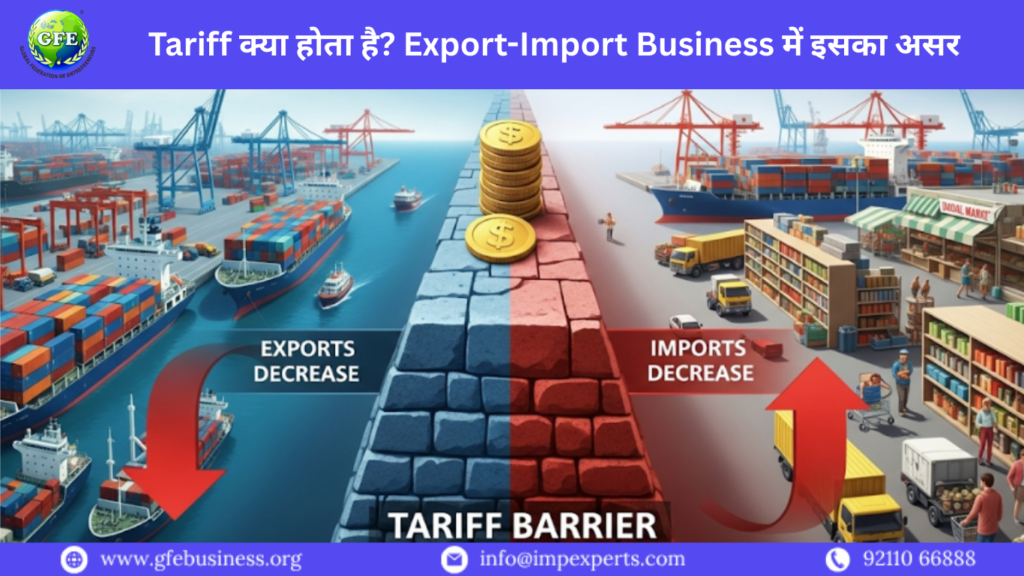If you are planning to step into the world of international trade, understanding tariffs is one of the most important aspects. A tariff is not just a tax—it is a tool governments use to regulate trade, protect domestic industries, and control foreign exchange flows. For exporters and importers in India, tariffs can be both an obstacle and an opportunity, depending on how well you understand and manage them.
Many first-time exporters fail to factor in the impact of tariffs on their pricing, costing, and final profit margins. That is why professionals and business owners often turn to platforms like GFE Business to gain structured training, compliance knowledge, and practical trade strategies. In this guide, we will break down Tariff क्या होता है, its types, impact on Export-Import Business, and how you can prepare to handle it effectively.
What is a Tariff?
In simple words, Tariff (टैरिफ) is a form of tax or duty imposed by a government on goods that are imported (brought into the country) or exported (sent out of the country).
Import Tariff – When goods come into India, customs duty is charged by the government.
Export Tariff – When goods are shipped out from India, certain duties may be levied.
Purpose of Tariffs:
Protecting domestic industries from cheap foreign competition.
Generating revenue for the government.
Regulating the balance of trade.
Encouraging local production over imports.
👉 Example: If the U.S. imposes a 20% tariff on Indian textiles, it means buyers in America will have to pay 20% more on the landed cost of that product. This directly affects demand and competitiveness.
Types of Tariffs
1. Ad Valorem Tariff (मूल्य आधारित शुल्क)
A percentage of the product’s value is charged as duty.
Example: If your export invoice is worth $50,000 and the ad valorem tariff is 10%, then $5,000 will be added as duty.
2. Specific Tariff
A fixed fee based on quantity, weight, or volume.
Example: $100 per ton of imported steel.
3. Mixed Tariff
A combination of ad valorem and specific tariff.
Example: 5% of value + $50 per unit.
4. Protective Tariff
Designed to protect local industries by making foreign goods more expensive.
5. Revenue Tariff
Primarily imposed to raise money for the government, not necessarily to restrict trade.
How Tariffs Affect Export-Import Business
1. Impact on Costing & Pricing
When tariffs are imposed, the landed price of your product in the destination country increases. If buyers find it expensive, they may shift to competitors from countries with lower tariffs.
2. Global Competitiveness
High tariffs make Indian products less competitive compared to exporters from nations with Free Trade Agreements (FTAs).
3. Profit Margins Shrink (Profit Margin घटता है)
Sometimes exporters bear part of the tariff cost to maintain buyers, which reduces overall margins.
4. Market Entry Barriers
Tariffs create hurdles for new exporters who want to enter highly regulated markets like the U.S. or EU.
5. Trade Diversification
Tariff shocks often push exporters to look for alternative markets.
Real-World Examples
Textile Industry: U.S. imposed higher duties on Indian apparel, forcing many exporters to look at Europe and Middle East.
Seafood Industry (Shrimp): Tariffs combined with strict quality standards reduced U.S. demand, but opened opportunities in Japan and South Korea.
Pharma Industry: Lower tariffs in certain African countries gave Indian pharma firms a competitive edge.
How Exporters Can Handle Tariff Challenges
1. Market Diversification (नए बाज़ारों की तलाश)
Do not rely only on the U.S. or EU. Explore Asia-Pacific, Middle East, Africa, and Latin America where tariffs may be lower.
2. Use FTAs & Trade Agreements
India has trade agreements with several countries (like ASEAN, Japan, and South Korea) where tariffs are reduced or eliminated. Exporters must take advantage of these pacts.
3. Value Addition Matters
Exporting raw cotton may attract higher tariffs, but finished garments often have better demand and margins. Always focus on value-added exports.
4. Leverage Government Schemes
Programs like RoDTEP, EPCG, and Duty Drawback help exporters recover costs incurred due to duties and taxes.
5. Export Financing & Risk Management
Financial institutions like EXIM Bank offer credit, insurance, and hedging solutions to protect against tariff risks and currency fluctuations.
Importance of Documentation
Tariff rates often depend on proper classification and documentation.
HS Code Classification: Wrong HS code can lead to higher duties.
Certificate of Origin (COO): Essential for claiming reduced tariffs under FTAs.
Commercial Invoice & Packing List: Customs rely on these documents for tariff calculation.
📌 Tip: Always double-check your HS code with DGFT or customs authorities before shipping.
Case Study: Surat-Based Textile Exporter
A textile exporter from Surat was heavily dependent on the U.S. market. After tariffs increased, he suffered losses as buyers reduced orders. Instead of shutting operations, he:
Entered European and Middle Eastern markets.
Used FTA benefits to lower duties.
Partnered with online B2B platforms to connect directly with new buyers.
Within two years, his export volume increased by 30% despite U.S. tariff challenges.
Opportunities Hidden in Tariff Challenges
Regional Demand: Countries like Brazil, South Africa, and UAE often import Indian goods at competitive tariffs.
Niche Products: Organic food, handicrafts, and specialized machinery face less tariff pressure in many markets.
E-commerce Growth: Selling via Amazon Global, Alibaba, and Shopify allows exporters to bypass certain middlemen and negotiate better pricing even in tariff-heavy markets.
Final Thoughts
Tariffs are one of the most influential factors in Export-Import Business. They can either restrict your growth or push you to explore new markets and strategies. The key is to stay informed, adapt quickly, and leverage government policies and trade agreements.
If you are just starting in global trade, don’t let tariffs scare you. With proper training and strategic planning, they can be managed effectively.
For exporters who want to learn compliance, documentation, market research, and tariff management, platforms like GFE Business provide practical guidance and training to help you succeed globally.
📞 Want to secure your export-import business against tariff risks and grow internationally? Visit 👉 GFE Business today.








